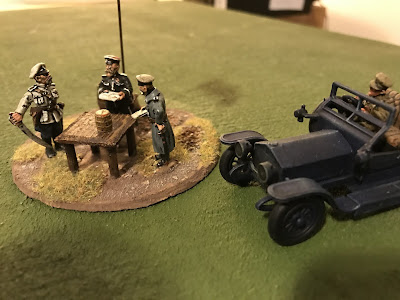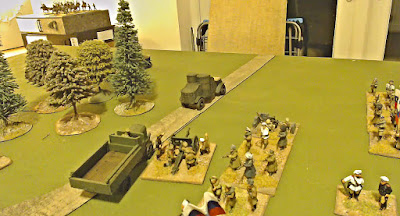This week's game was an American War of Independence Clash, the scenario was based on The Battle of The Clouds and used a set of club rules drawing inspiration from Black Powder.
The Americans are deployed across the board under Washington, preventing the British from moving up the two roads.
General Washington (Average)
Green (Average) (numbers in brackets indicate the unit in the picture below)
1st Division - 1st Brigade – Muhlenburg (4)
16 figures, 4 stands, Trained
1st Division - 2nd Brigade – Muhlenburg (3)
16 figures, 4 stands, Trained
4th Division – Wayne (2)
24 Figures, 6 stands, Trained
Maxwell's Light Infantry (1)
12 figures, 3 stands, Trained
6 pdr gun Veteran
Whilst the British under General Howe, were driving up the two roads in a manner that would clearly lead to a split battle of two wings.
General Howe (Average)
Right Wing - Cornwallis (Excellent)
Advance Guard (Queens Rangers Light Infantry) (13)
8 figures, 2 stands, Trained
1st Brigade - Grant (15)
24 figures, 6 stands, Veteran
2nd Brigade – Vaughan (14)
20 figures, 5 stands, Veteran
Hessian 1st Brigade – Stirn (16)
16 figures, 4 stands, Trained
6pdr gun Veteran
Left Wing - Knyphausen (Average)
Light Infantry and Guards Brigade – Matthew (10)
20 figures, 5 stands, Elite
Hessian 2nd Brigade - von Donop (9)
24 figures, 6 stands, Trained
4th Brigade – Agnew (11)
20 figures, 5 stands, Trained
3rd Brigade – Grey (12)
16 figures, 4 stands, Veteran
The British "Half a plan" involved Knyphausen driving Mathew's Brigade through the woods, splitting the American line and exiting the board by the road beyond. Cornwallis was tasked with pinning the Americans in front of him so that they could do little to support the beleaguered center.
The plan however, began to fall apart from the first moment of the game (when doesn't it). The vagaries of battle deployment meant that Von Donop's brigade were deployed at the head of the column instead of the Lights, and they couldn't get through the wood.
To further complicate matters, issues with command and control often meant that brigades stubbornly refuse to move, usually at critical moments meaning it's very difficult to put together a coordinated attack.
The first turn saw Maxwell's Lights move forward and act as skirmishers on the Knyphausen's flank. The rest of the American forces waited to see where the British attack was going to come from. Knyphausen moved the Hessians up and inclined slightly towards the wood, with the intention of staying hidden from American artillery whilst the Lights would push through.
Cornwallis moved his brigades forward and the Queen's Rangers also moved up to the wood in front of them with the intention of harrasing the Americans beyond the road.
American artillery opened up but there were no casualties on either flank and the British were relieved by the fact that the bodies had not started to pile up yet as they faced a potential storm of shot.
The second turn saw the British gain the initiative. Again, Knyphausen urged his men up the road but the half plan was abandoned in favour of a determined push into the mouth of hell. General Howe dug his heels into the flanks of his horse and dashed across the field to stiffen resolve if it should falter. Cornwallis continued to advance and the Queen's reached the edge of the wood.
The American Lights moved along von Donop's flank and began sniping, causing one casualty. Muhlenburg's second division wheeled and moved up the road to prepare flanking fire for the advancing Hessians. On the other wing, the American brigades mirrored the other flank and began to take up positions which would allow them to create a killing field.
The American artillery had found its range, causing two casualties on von Donop's Hessians and on the other flank one casualty to Grant's Brigade. The only British shooting resulted in one casualty on the American Lights.
It was at this point that Howe had hoped that Cornwallis would use Grant's Brigade and the Artillery to pin the American left whilst he made a dash down the road in an attempt to outmaneuver the Americans and give the British a sporting chance of achieving the objective. Cornwallis however continued to advance up the flank, heading straight for the carefully prepared cross fire. This was exactly the same situation as was developing on the American right flank.
Turn Three saw the Americans gain the initiative. The lights continued to harry the poor Hessians who steadfastly ignored them and kept pushing up the road.
Hits from the artillery meant that the Hessians lost a base. The American Lights fired at the Guards, causing one casualty and scored a further casualty on the 4th Brigade behind them. The Hessian morale stood firm as they drew ever closer to the artillery. Over on the other flank, the American artillery missed and the British continued up the road whilst the Americans waited, inclined to maximise their fire power when the British appeared around the wood.
Turn Four saw the British gain the initiative and they determinedly continued with their advance into the very teeth of the American guns. Cornwallis ordered his artillery around the wood and deployed dangerously close to the American line. Grant and Vaughan moved their brigades up slightly whilst the British skirmishers moved through the wood with the intention of finally finding a target.
The American left flank remained stationary whilst on the right, the gun pivoted to catch the hessians in its arc of fire and Muhlenburg moved up the hill to act as a reserve if the British succeeded in punching through.
The shooting phase saw volley after volley of devastatingly effective fire from the Americans. The British artillery lost three casualties and the crew promptly fled into the safety of the wood. The beleaguered Hessians bore the worst on the American right, losing two bases. The resulting morale check meant that they routed, and streamed down the road past the Lights and the 3rd Brigade who fortunately stood firm. All credit to General Green who had positioned his forces to create a deadly cross fire, whilst the American Lights had accomplished their purpose admirably.
Cornwallis faces the same horrific cross fire as von Donop. Washington, positioned near the farmhouse, looks on with grim satisfaction.
Turn five saw the slight adjustment of the American right flank to face the threat of the British Lights who were closing on Wayne's battered division. Muhlenburg formed into line behind them as support whilst General Howe failed to stop the rout of the Hessians who were removed from the field.
The shooting phase saw more misery for the British as the Lights lost two bases but stood firm. Their return fire on Wayne's division caused slight consternation as a musket ball whistled close to their General. The British skirmishers on the other flank were finally in a position to fire upon the enemy, whilst Washington closed in on the advancing British using the wood to secure his flank.
And there we paused the game until next week. The British face a monumental task. The terrain means that they are funneled into two narrow channels that have become killing fields. The often ponderous nature of movement and a reluctance to follow orders makes mounting an attack in which wave after wave drives the enemy back is extremely difficult. It remains to be seen whether the British can crack a hole in the line and take advantage of this to roll up the enemy either side. Will they falter as they step over the pile of dead into the very teeth of the guns and muskets lined against them?
















































